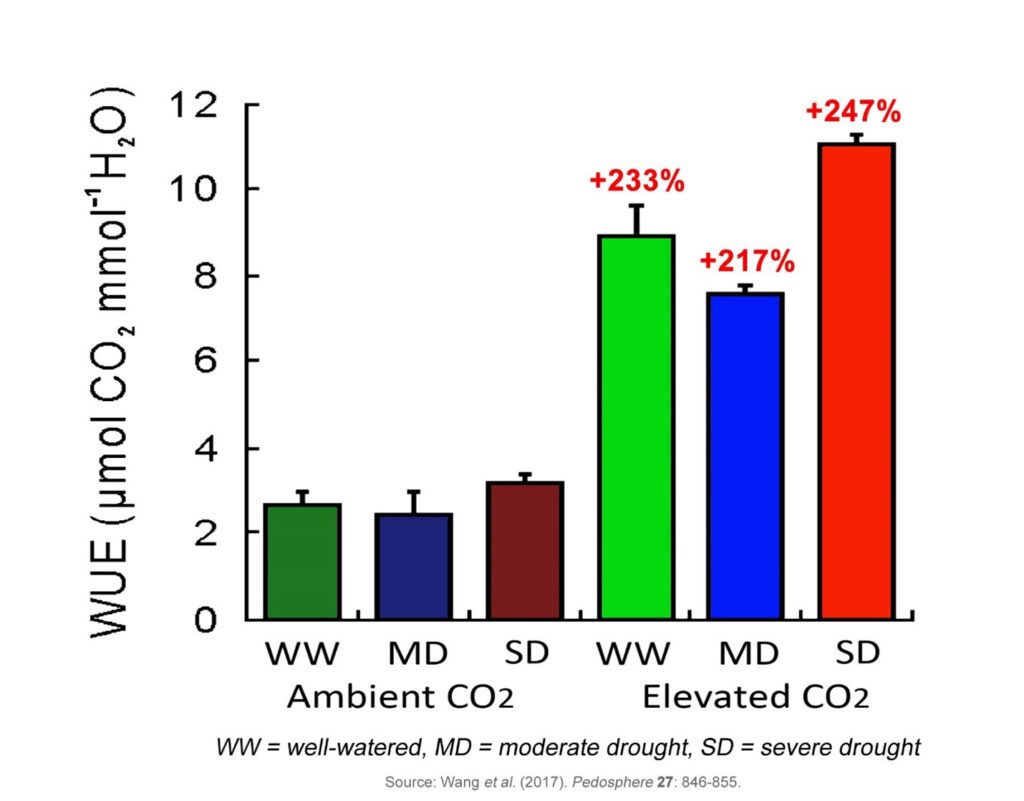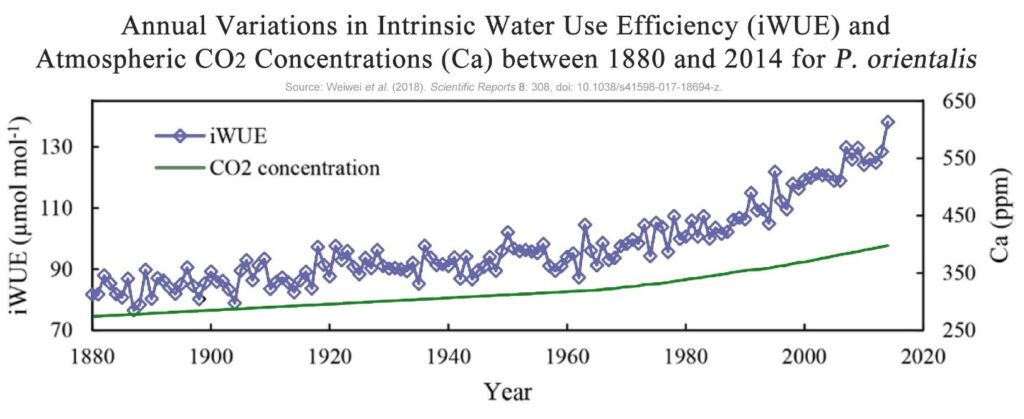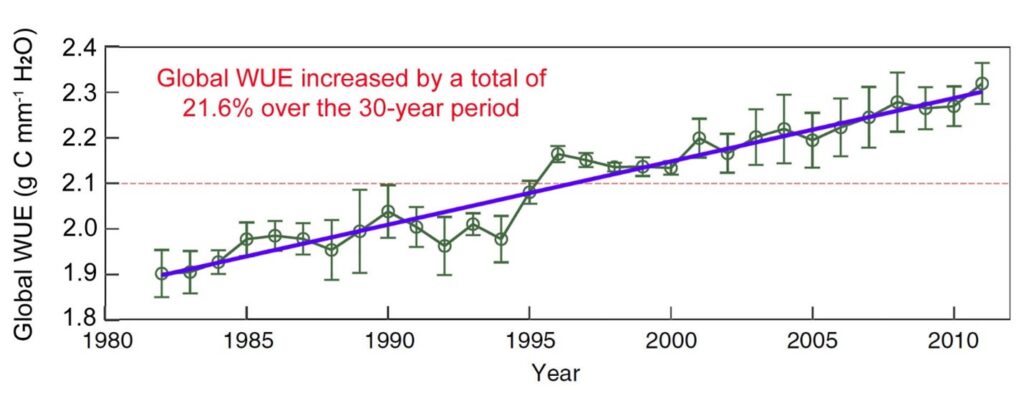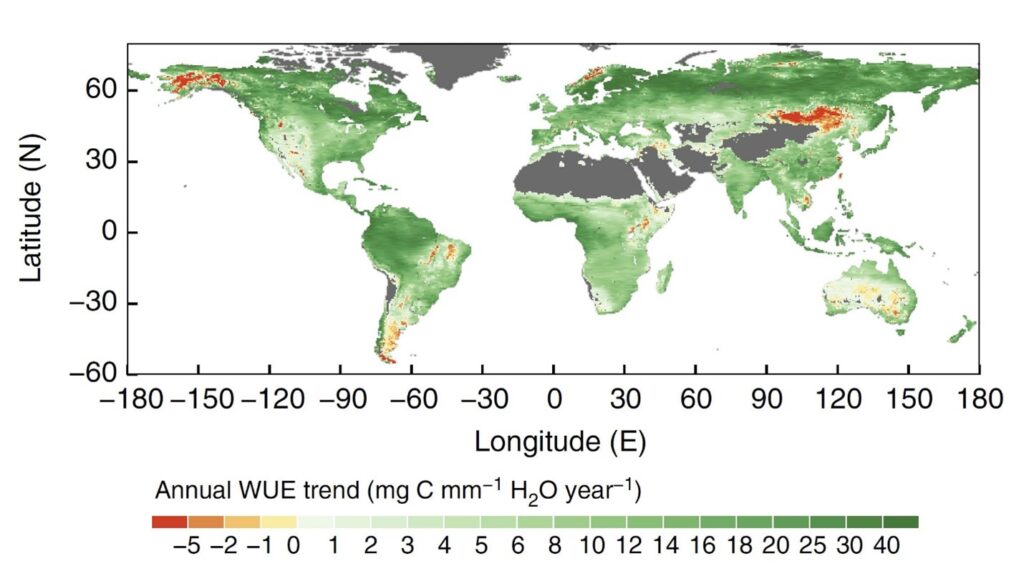CO2 Enrichment Improves Plant Water-Use Efficiency
By Craig D. Idso -- May 20, 2022“Gratefully, nature does not have to wait another century or so for the air’s CO2 concentration to double before reaping benefits from enhanced water use efficiency. It has already begun to profit in this regard from the approximate 50% increase in atmospheric CO2 that has occurred since the Industrial Revolution began.”
In my last article I wrote about increased plant productivity as a key ecological benefit of atmospheric CO2 enrichment. This article highlights another well-known and near-universal impact of Earth’s rising carbon dioxide concentration—enhanced plant water-use efficiency.
In basic terms, plant water use efficiency is the amount of biomass produced by a plant per unit of water lost via transpiration. At higher CO2 levels plants generally do not open their leaf stomatal pores through which they give off water vapor as wide as they do at lower CO2 concentrations.
The smaller pore openings make it more difficult for water within the sub-stomatal cavities of the leaves to escape to the air. Consequently, elevated CO2 not only enhances plant photosynthesis and growth, it also reduces plant water loss by transpiration, which combination of factors improves plant water use efficiency.
The magnitude of this incredible benefit varies by plant and growing conditions. Nevertheless, most plants experience water use efficiency gains on the order of 70 to 100%–or more—for a doubling of atmospheric CO2 (see and read reviews of multiple peer-reviewed studies under subheadings of Water Use Efficiency here on my CO2 Science website).
As an example of this phenomenon, Figure 1 shows the effects of elevated CO2 and plant water supply on the water use efficiency of soybeans. The plants were grown in controlled-environment greenhouses for 40 days under ambient or twice ambient CO2 concentrations and one of three water treatments: well-watered, moderate drought or severe drought.
Regardless of watering treatment, the scientists who conducted this study found that a doubling of CO2 significantly increased the water use efficiency of these plants by a whopping 217 to 247%!

Figure 1. Water use efficiency (WUE) of soybean plants grown for 40 days under various water-supply treatments (WW = well-watered; MD = moderate drought; SD = severe drought) and atmospheric CO2 (ambient and elevated, elevated = twice ambient). The numbers in red text indicate the percent enhancement of plant WUE under elevated CO2 for a given water supply treatment. Source: Wang et al. (2017).
Gratefully, nature does not have to wait another century or so for the air’s CO2 concentration to double before reaping benefits from enhanced water use efficiency. It has already begun to profit in this regard from the approximate 50% increase in atmospheric CO2 that has occurred since the Industrial Revolution began.
Evidence of this fact is frequently noted in scientific studies utilizing dendrochronological methods and stable isotope analyses on long-lived tree species from all across the globe. Figure 2, for example, depicts the change in atmospheric CO2 and water use efficiency for an evergreen coniferous species in China. Since 1880, the rise in atmospheric CO2 has helped boost the water use efficiency of these trees by an incredible 60%.

Figure 2. Annual variations in tree-ring averaged intrinsic water use efficiency (iWUE) and atmospheric CO2 concentrations (Ca) between 1880 and 2014 for P. orientalis. Source: Weiwei et al. (2018).
Similar-magnitude increases in water use efficiency have also been noted in Douglas fir and Ponderosa pine from the United State, in Norway spruce in Italy and Germany, cypress trees in southern Chile, Juniper, Acacia and Aleppo Pines in northern Africa, as well as a host of other trees from numerous other locations (see many examples here). But perhaps the best evidence of a modern increase in water use efficiency due to rising levels of atmospheric CO2 comes from a key study published by Cheng et al. (2017) in the scientific journal Nature Communications.
Using a combination of ground-based and remotely sensed land and atmospheric observations, the authors of this seminal work performed a series of calculations to estimate changes in global water use efficiency over the period 1982 to 2011.
Results of their work, as shown in Figure 3, reveal that global water use efficiency increased at a mean rate of 13.7 milligrams of carbon per millimeter of water per year, experiencing a phenomenal 21.6% enhancement over this three-decade-long period, almost all of which was attributed to rising atmospheric CO2.
What is more, the authors report that this increase did not come at a cost of enhanced global terrestrial water use. Instead, rising atmospheric CO2 improved the global carbon uptake per unit of water used, meaning that plants today are larger and produce significantly more biomass than 30 years ago without needing any more water to do so, which finding holds extremely important ramifications for the future growth and survival of both plant and animal species.

Figure 3. Estimated trends in global water use efficiency (WUE) over 1982-2011. Annual mean anomalies (with linear trend line) are presented along with associated standard deviations of global WUE. Source: Cheng et al. (2017).
Finally, Figure 4 presents a spatial view of the global water use efficiency trends reported in the Nature Communications study. As is clearly evident by the various degrees of green shading, a full 90 percent of the global vegetated land area show positive, increasing trends in water use efficiency, which finding is actually quite impressive considering there were large-scale disturbances such as heat waves and droughts over the study period that should have adversely impacted water use efficiency in many regions. So why didn’t they?

Figure 4. Estimated spatial trends in annual water use efficiency over 1982-2011. Source: Cheng et al. (2017).
The reason, as you might have already guessed, is because of CO2. Thanks to rising levels of this key atmospheric trace gas, the world’s vegetation has met and largely overcome a host of debilitating influences that should have reduced plant water use efficiency in more locations than shown on the preceding map.
And as CO2 emissions from fossil fuel use continue to increase in the years and decades ahead, the observed positive enhancements to plant water use efficiency will increase even more, as the authors of this Nature Communications study further report a 10% increase in atmospheric CO2 induces a 14% increase in global water use efficiency.
So it is that nature truly benefits from rising levels of atmospheric carbon dioxide. Far from being a pollutant, atmospheric CO2 is necessary for enhancing life.
References
Cheng, L., Zhang, L., Wang, Y.-P., Canadell, J.G., Chiew, F.H.S., Beringer, J., Li, L., Miralles, D.G., Piao, S. and Zhang, Y. 2017. Recent increases in terrestrial carbon uptake at little cost to the water cycle. Nature Communications 8: 110, DOI:10.1038/s41467-017-00114-5.
Wang, Y., Yan, D., Wang, J., Sing, Y. and Song, X. 2017. Effects of elevated CO2 and drought on plant physiology, soil carbon and soil enzyme activities. Pedosphere 27: 846-855.
Weiwei, L.U., Xinxiao, Y.U., Guodong, J.I.A., Hanzhi, L.I. and Ziqiang, L.I.U. 2018. Responses of intrinsic water-use efficiency and tree growth to climate change in semi-arid areas of north China. Scientific Reports 8: 308, doi: 10.1038/s41598-017-18694-z.